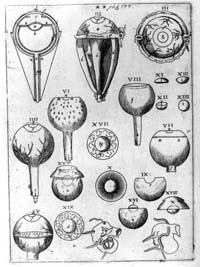Kepler's Books
Books were one of the ways in which
Kepler sought to secure a moderate income. The dedicatees of Kepler's numerous publications on
astrology,
astronomy, chronology and snowflakes indicate the range of patrons whom Kepler hoped to, and had to, rely upon for his livelihood. For instance, the
Mystery of the Universe (1596) was dedicated to the Estates of Styria, where Graz was located. In 1600, in appreciation of the dedication, the representatives of Styria paid Kepler 250 gulden. Kepler had to pledge to take two hundred copies from the printer, for which he paid 33 gulden. Kepler sent on fifty copies to Maestlin for distribution in Tübingen. Kepler dedicated books to Julian de'Medici in return for transmitting Galilei's
Starry Messenger, and to Duke Ernst of Cologne for favouring him with the use of his
telescope. He also dedicated the
Harmony of the Universe (1619) and the
Chilias Logarithmorum (1624) to Landgrave Philip of Hesse, who had an astronomical observatory at Butzbach. Kepler had earlier observed the sunspots with Philip, and hoped to find support from him, in vain. Kepler's last work, published posthumously, was also dedicated to Philip of Hesse by Kepler's son. The
Dream or astronomy of the moon (1634) was begun by Kepler in his student days, showing how the planetary motions would appear to the imaginary inhabitants on the moon, by which he sought to demonstrate the motion of the earth. Kepler also wrote books in friendship. Matthaüs Wackher, a self-made man who eventually became the imperial treasurer, shared mathematical interests with Kepler and became a godfather to his son. Wackher was also the first to report to Kepler about Galileo's telescope. Kepler dedicated to him
A New Years' Gift, or the Six-Cornered Snowflake (1611), which discussed the reason for the six-angled shape of the snow crystals and the forms and symmetries in nature.
 Diagrams of the eye from Kepler's Ad Vitellionem Paralipomena.
Diagrams of the eye from Kepler's Ad Vitellionem Paralipomena.
 Diagrams of the eye from Kepler's Ad Vitellionem Paralipomena.
Diagrams of the eye from Kepler's Ad Vitellionem Paralipomena.